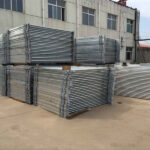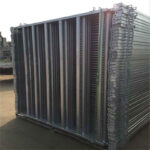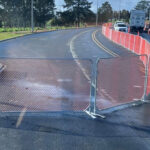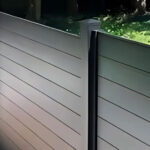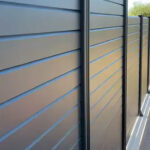Harris fencing, a popular type of temporary fencing, has become a staple in construction sites, events, and other applications requiring short-term perimeter security. But have you ever wondered why it’s called Harris fencing? Let’s delve into the history, characteristics, and applications of this versatile fencing solution.
The Origins of Harris Fencing
The name “Harris fencing” originates from its inventor, John Harris, who developed this type of temporary fencing in the 1970s. John Harris, an Australian entrepreneur, recognized the need for a more efficient and versatile temporary fencing solution in the construction industry. His innovative design quickly gained popularity and became widely known as “Harris fencing.”Paneles de cercado temporales have come a long way since their inception, but the basic principles of Harris’ design remain influential in modern temporary fencing solutions.
Key Features of Harris Fencing
Harris fencing is characterized by several key features that set it apart from other temporary fencing options:
- Diseño modular: Harris fencing panels are designed to be easily connected and disconnected, allowing for quick installation and removal.
- Sturdy Construction: Typically made from galvanized steel, Harris fencing is durable and weather-resistant.
- Versatilidad: The fencing can be adapted to various terrains and applications, making it suitable for construction sites, events, and more.
- Características de seguridad: Many Harris fencing panels include anti-climb measures and high visibility elements for enhanced security.
These features have contributed to the widespread adoption of Harris fencing across various industries.
Applications of Harris Fencing
The versatility of Harris fencing has led to its use in numerous applications:
- Sitios de construcción: Providing perimeter security and defining work zones.
- Eventos: Creating temporary boundaries and managing crowd flow at festivals, concerts, and sporting events.
- Respuesta de emergencia: Quickly establishing secure areas in disaster zones or accident scenes.
- Almacenamiento temporal:Asegurar áreas de almacenamiento al aire libre para uso a corto plazo.
- Paisajismo:Proteger áreas de nueva plantación o delimitar zonas de trabajo en parques y espacios públicos.
Barreras de control de multitudes, which are often used in conjunction with Harris fencing, provide additional flexibility for managing pedestrian traffic at events and construction sites.
The Evolution of Temporary Fencing
Since the introduction of Harris fencing, the temporary fencing industry has seen significant advancements:
- Materiales: While galvanized steel remains popular, manufacturers now offer options in aluminum and high-strength plastics for specific applications.
- Design Improvements: Modern temporary fencing often includes features like anti-trip bases and integrated shade cloth attachments.
- Specialized Variants: The industry has developed specialized fencing for specific needs, such as noise reduction panels for construction sites near residential areas.
- Cercas inteligentes: Some manufacturers are incorporating IoT technology for enhanced security monitoring and access control.
Abrazaderas temporales para cercas have also evolved, offering more secure and easier-to-use connections between panels.
The Impact of Harris Fencing on the Construction Industry
Harris fencing has had a significant impact on the construction industry:
- Improved Site Safety: By providing a clear boundary, Harris fencing has helped reduce accidents and unauthorized access to construction sites.
- Cost Efficiency: The reusable nature of temporary fencing has led to cost savings for construction companies.
- Flexibility in Project Management: Easy-to-move fencing allows for more dynamic site management as construction progresses.
- Cumplimiento de la normativa: Harris fencing helps construction companies meet safety and security regulations more easily.
Harris Fencing vs. Other Temporary Fencing Solutions
While Harris fencing remains popular, it’s worth comparing it to other temporary fencing options:
| Tipo de cercado | Ventajas | Desventajas |
|---|---|---|
| Harris Fencing | Durable, modular, widely available | Can be more expensive initially |
| Plastic Mesh Fencing | Very lightweight, low cost | Less secure, less durable |
| Cercado temporal de alambre de cadena | Good visibility, familiar design | Heavier, can be more time-consuming to install |
| Paneles de acaparamiento | Provides privacy, can be branded | More expensive, less flexible |
Chain link fence panels offer an alternative to traditional Harris fencing in some applications, particularly where visibility through the fence is desired.
Consideraciones ambientales
A medida que la sostenibilidad adquiere cada vez más importancia, vale la pena considerar el impacto ambiental de las cercas temporales:
- Reciclabilidad: Most Harris fencing panels are made from recyclable materials.
- Reutilización: The durable nature of Harris fencing allows for multiple uses, reducing waste.
- Transportation Efficiency: The modular design allows for efficient transportation, potentially reducing carbon emissions.
Some manufacturers are now offering base de caucho reciclado options for temporary fencing, further improving the environmental credentials of these systems.
The Global Spread of Harris Fencing
While Harris fencing originated in Australia, it has since spread globally:
- North America: Widely adopted in the United States and Canada for construction and event management.
- Europe: Popular in the UK and increasingly used across the European Union.
- Asia: Growing adoption in rapidly developing countries for construction projects.
- Africa: Increasingly used in mining and large-scale construction projects.
Innovations in Harris Fencing
Recent innovations in Harris fencing technology include:
- Lightweight Alloys: New materials offering the strength of steel at a fraction of the weight.
- Anti-Corrosion Coatings: Advanced treatments to extend the life of fencing in harsh environments.
- Integrated Solar Lighting: Some panels now include solar-powered lights for enhanced visibility and security.
- RFID-Enabled Panels: For improved inventory management and theft prevention.
Maintenance and Care of Harris Fencing
Proper maintenance can significantly extend the life of Harris fencing:
- Inspecciones periódicas para detectar daños o desgaste.
- Cleaning, especially in dusty or muddy environments
- Proper storage when not in use
- Immediate repair or replacement of damaged components
El futuro de las vallas temporales
As urban development and event management continue to evolve, we can expect further advancements in temporary fencing technology:
- Cercas inteligentes: Integration with IoT and AI for enhanced security and management.
- Materiales ecológicos: Development of biodegradable or carbon-negative fencing materials.
- Modular Power and Data Integration: Fencing that doubles as a temporary infrastructure for power and data distribution.
- Enhanced Customization: 3D-printed components for highly specialized fencing needs.
Regulatory Considerations
It’s important to note that the use of temporary fencing, including Harris fencing, is often subject to local regulations:
- Restricciones de altura: Many jurisdictions have maximum height limits for temporary fencing.
- Permit Requirements: Some areas require permits for the installation of temporary fencing, especially for longer-term use.
- Safety Standards: Fencing must often meet specific safety standards, particularly in public spaces or construction sites.
Consideraciones de costos
The cost of Harris fencing can vary depending on several factors:
- Purchase vs. Rental: For short-term needs, renting may be more cost-effective.
- Quality and Features: Higher-quality fencing with additional features will generally cost more.
- Quantity: Bulk purchases or rentals often come with discounts.
- Instalación: Professional installation adds to the cost but ensures proper setup.
Conclusion: The Enduring Legacy of Harris Fencing
So, why is it called Harris fencing? It’s a testament to the innovative spirit of John Harris, whose design revolutionized temporary fencing. Today, the term “Harris fencing” has become synonymous with high-quality, versatile temporary fencing solutions used worldwide.From its humble beginnings in Australia to its global adoption, Harris fencing has proven its worth in countless applications. As we look to the future, it’s clear that the principles behind Harris fencing will continue to influence the development of temporary perimeter solutions, adapting to new challenges and technologies while maintaining the core benefits that made it so popular in the first place.Whether you’re a construction professional, event organizer, or simply curious about the world around you, understanding the history and applications of Harris fencing provides valuable insight into how innovative solutions can shape industries and practices worldwide.
Preguntas frecuentes
What materials are typically used in Harris fencing? Harris fencing is most commonly made from galvanized steel for durability and weather resistance. However, some manufacturers also offer aluminum or high-strength plastic options for specific applications.How long does it take to install Harris fencing? The installation time for Harris fencing can vary depending on the size of the area and the number of workers. However, a typical 100-meter run can often be installed by a small team in just a few hours.Can Harris fencing be used for long-term applications? While designed primarily for temporary use, Harris fencing can be used for longer-term applications with proper maintenance. However, for permanent fencing needs, other solutions may be more appropriate.Is Harris fencing suitable for all weather conditions? Harris fencing is generally designed to withstand various weather conditions. However, in extreme weather events, additional measures may be necessary to ensure the fencing remains secure.How does the cost of Harris fencing compare to permanent fencing options? For short-term needs, Harris fencing is often more cost-effective than permanent fencing. However, for very long-term use, permanent fencing may prove more economical. It’s important to consider the specific needs and duration of your project when making this decision.



